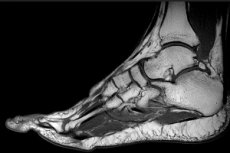MRI of the foot
Last reviewed: 23.04.2024

All iLive content is medically reviewed or fact checked to ensure as much factual accuracy as possible.
We have strict sourcing guidelines and only link to reputable media sites, academic research institutions and, whenever possible, medically peer reviewed studies. Note that the numbers in parentheses ([1], [2], etc.) are clickable links to these studies.
If you feel that any of our content is inaccurate, out-of-date, or otherwise questionable, please select it and press Ctrl + Enter.

Indications for the procedure
Magnetic resonance imaging - MRI of the foot - is prescribed to patients with complaints of pain in the foot or ankle, joint stiffness and walking problems. Visualization is carried out to accurately determine the pathological changes in anatomical structures that allow us to establish the true causes of the pain syndrome, which can occur for a variety of reasons, in particular:
- at fractures of bones;
- in difficult cases of sprain;
- due to damage (rupture) or enthesopathy of the Achilles tendon;
- if the joints of the interphalangeal joints of the fingers are inflamed (with arthritis and arthrosis) or their articular bags with the development of bursitis of the foot;
- in connection with the deformation of the joints and the development of ankylosis;
- when the fascia of the sole is inflamed, that is, with plantar fasciitis;
- if an articular tumor is formed - hygroma of the foot ;
- with inflammation of soft tissues (abscess, phlegmon, diabetic foot, gout ).
MRI of the heel of the foot is carried out, first of all, with the formation of a marginal osteophyte (heel spur), as well as inflammation of the calcaneus (epiphysitis, osteonecrosis); damage or deformation of the calcaneal (Achilles) tendon.
This diagnostic method is indispensable for choosing the optimal tactics of any surgical interventions, including - for the purpose of correction of congenital defects of the feet (peremelia, syndactyly, ectrodactyly, horse foot).
Preparation
The preparation for any MRI is that the patient must get rid of all metal objects before starting the procedure.
 [6]
[6]
Technique MRI of the foot
When using a closed scanner (tunnel type) or an open panoramic scanner, the patient assumes a horizontal position, the limbs are fixed, since during scanning a complete immobility is important. There are models of tomographs that allow to conduct a survey when the patient is sitting.
The average duration of the MRI of the foot is half an hour. Any care after the procedure is not needed.
What does the MRI of the foot show?
On three-dimensional images obtained by means of magnetic resonance imaging, doctors clearly see the existing changes and damage to bone structures.
MRI of the joints of the foot - subtaran, talus-calcaneo-navicular, heel-cuboid, wedge-navicular joints, tarsus-metatarsal, interplus and interphalangeal articulations - shows the state of all joint structures. This applies to the joint bag and its synovial membrane, the epiphyses of the joint-forming bones, the joint cavity and cartilage.
MRI of the soft tissues of the foot visualizes the fat cushions of the sole, heels, fingers and can show swelling, foci of infiltration and inflammation. In addition, an image of all the muscles of the back and plantar part of the foot, all tendons and tendon ligaments, blood vessels and nerves are obtained.
Although the images are stored on a computer and printed on film or electronic media, the radiologist (a specialist in tomography diagnostics) compiles a medical report, decoding or description of the MRI of the foot - indicating the pathological changes, their nature and exact localization.
Contraindications to the procedure
MRT scanning, including stops, is contraindicated in the presence of patients: pacemaker; continuously injecting insulin devices (insulin pump); cochlear implants; metal stents, surgical clips, pins, plates, screws, etc.
Contra-indications also include the first trimester of pregnancy; inability to remain in a state of complete immobility for a minimum of 30 minutes; the presence of such a psychopathic syndrome as claustrophobia.
Complications after the procedure
In MRI, radio-frequency pulses passing through the electromagnetic field are used, therefore, the consequences associated with the "irradiation" of the organism, that is, the action of ionizing radiation, are absent.
However, in some patients - only in cases of exceeding the voltage of the electromagnetic field - such minor complications after the procedure as mild dizziness, short-term fascinations (spontaneous twitching of individual muscle fibers) and the taste of metal in the mouth can be observed.
But the responses of the majority of patients about their well-being after magnetic resonance imaging do not contain any complaints.
Which is better, CT or MRI of the foot?
Given the significance of the results of MRI of the foot for the correct diagnosis and the choice of optimal treatment tactics, this method of instrumental diagnostics is preferable to CT, since it visualizes the foot structures in different planes and with a higher contrast (especially in the dense connective tissue of cartilages and ligaments).
In addition, unlike CT (where ionizing radiation is used), MRI does not apply to X-ray methods, and the frequency of its use is unlimited.

